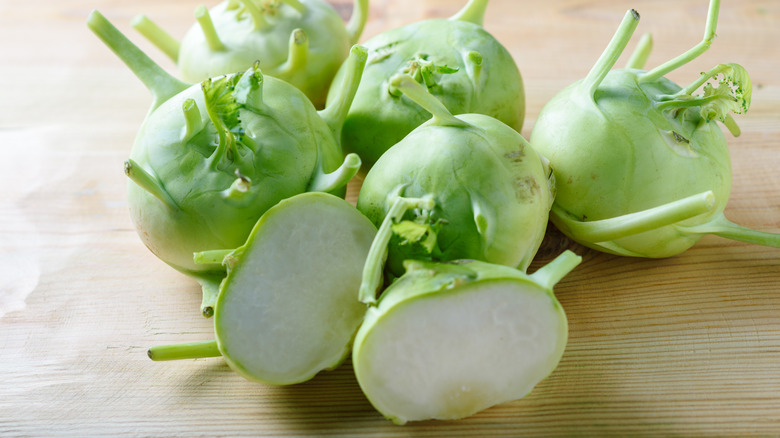You've Been Cutting Kohlrabi Wrong This Whole Time
Kohlrabi may not be the most ubiquitous food, but if you're unacquainted with the gnarled vegetable, be sure to try one out ASAP! They're delicious, very healthful, and a great alternative to some of the more well-known veggies out there.
Kohlrabi is especially well-regarded in European countries such as Germany, according to German Food Guide, and its largest edible component is its "bulb," or the bulbous root at the end of the stalks. Similarly to some other fruits and veggies, kohlrabi has a rather thick outer skin, so it's usually peeled prior to eating. However, its leaves are also totally edible, so don't forget to use those (via Bon Appétit).
Unbeknownst to some, kohlrabi is not a root vegetable. It is actually in the cabbage family along with broccoli and kale, according to Food Network, and its flavor profile is certainly in line with those vegetables (as well as turnips), but it also has a crisp lightness in its raw form that is more akin to radishes or even apples. But once you have one of these vegetables in your possession, how do you go about cutting it?
How do you prepare kohlrabi?
Kohlrabi can be roasted, sautéed, seared, steamed, boiled, or even mashed, but it's also important to note that eating kohlrabi raw (and ideally thinly sliced) is also an absolutely wonderful preparation, according to The Spruce Eats. As far as how to go about prepping your kohlrabi, Kitchn notes that is it important to peel the hard skin off with a vegetable peeler (or a paring knife, if you're particularly adept at peeling veggies).
The Spruce Eats also states that cutting the bulb in half first is also a good way to make the vegetable easier to handle during prep and to ensure that it is still fresh. It's also important to be sure to cut out the tough core. From there, you can save, cook, and eat the leaves, chop up the trimmed bulb into wedges or planks, or (carefully!) thinly shave the kohlrabi on a mandolin.
Nutritionally, The Spruce Eats notes that kohlrabi boasts a high-fiber and low-fat content, and it's also high in calcium and potassium. Martha Stewart also says that the vegetable is high in vitamin C. That's not all though. Healthline mentions that kohlrabi is also high in vitamin B6 and many antioxidants. So clearly, kohlrabi would be an excellent addition to any meal, not just for its flavor but for its health benefits, too.

